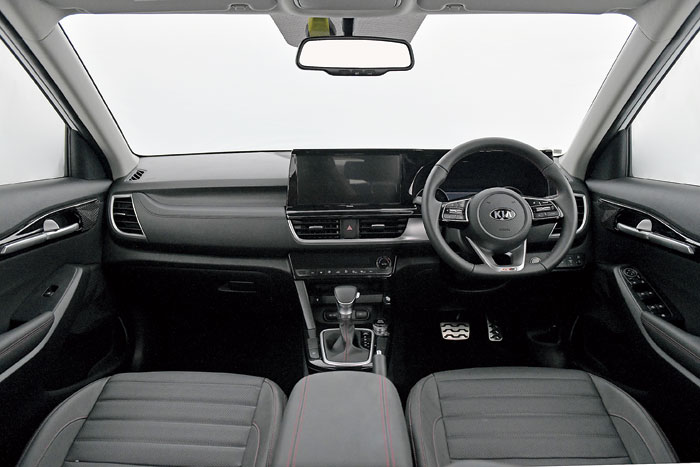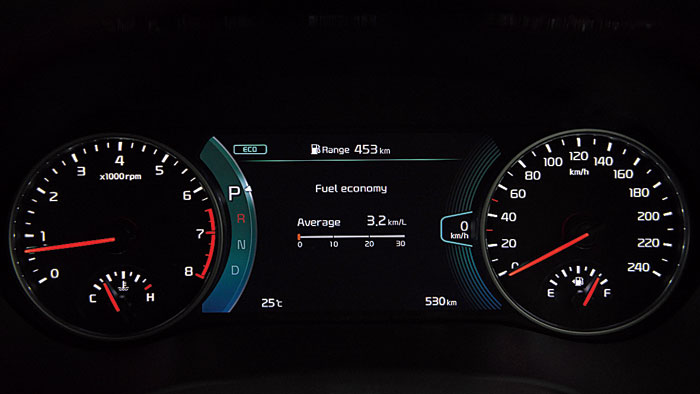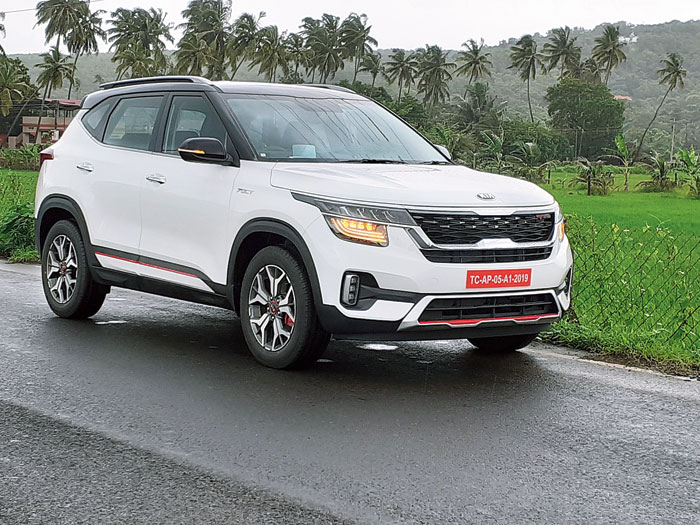From the air, Goa looked quite incredible. With the heavy rains that the place had been receiving, the greenery had turned lush. And the rivers and water bodies into which the red soil had been washed had acquired an unusual brightness. The two colours made each other pop — till the rains that came down in sheets turned everything grey again.
I was in Goa to drive the new Kia Seltos midsize SUV, which the company is to start delivering from next week. The carmaker had brought in loads of vehicles for the media to get a feel of. There were four variants. In the 1.5-litre diesel there were the six-speed manuals and automatics. Then there were the manual and automatic versions of the 1.4-litre turbo petrol.
There is also a 1.5-litre petrol version with manual and automatic in the line-up, but that was not available on this drive. All three engine options come with six-speed manuals and different automatics.
Then there are the Tech Line and the GT Line, and trim levels within those. In short, there are as many as 16 variants to choose from! So, one would need to go through the spec sheet closely to figure out what exactly s/he wants.
THE EXTERIORS
The Seltos looks good from the moment you first clap your eyes on it. The stance is broad with a boxy front end that subliminally conveys a sense of purposefulness. There’s just enough of textured chrome highlights to make it look upmarket as well. The SUV attitude bits, like scuff plates reminiscent of offroad excursions, are there too. The headlamp cluster of very complicated design with multiple layers of LEDs grabs attention as does the ‘tiger-nose’ grille and ‘ice cube’ fog lights.
In profile, the floating roof design works well. The 17-inch alloys fill out the wheel arches nicely and also prevent the profile from getting too bland.
The taillight design is rather nice and distinctive. The rear hatch door has lots of creases and surfaces that prevent it from looking slabby, but it possibly is a shade overdesigned.
The GT Line comes with red accents on the front and rear scuff plates and side rubber strip, red front wheel callipers and red stitching inside.

If the Kia Seltos gives a good positive vibe from the outside, it gets intensified when you get into the vehicle Pictures: Abhijt Mitra and Kia Motors
THE INTERIORS
If the Kia Seltos gives a good positive vibe from the outside, it gets intensified when you get into the vehicle. Almost everything that we touch and operate has a feel that’s very solid. The flat-bottom, multifunction steering wheel, gear lever, door handles and lock, switches, dials, seats, pretty much everything feels good. The design, particularly the way the dials look on the screen, and the overall layout would possibly not look out of place even in a luxury car.
The seats — all the cars we drove had ventilated ones — are excellent with the bolstering and support, making them very comfortable places to be. Visibility all around is good. The Seltos comes with features like the heads-up display that is a first in this segment. The windshield as well as the door windows have glass that reduces the amount of UV getting into the car. The windows also have sun shade curtains that should work to keep the interiors cool.
There is also an air purifier built into the vehicle that should rid the car of pollutants as well as undesirable odour.
The big, 10.25-inch HD infotainment touchscreen supports lots of functions. Again, in a segment first, the SIM-based connectivity that works with the UVO app allows features like geo fencing and diagnostics to work through a paired phone. There are other features like SOS alerts as well.
THE POWERTRAIN
There are three powertrains on offer — a 1.4-litre turbo petrol, a naturally aspirated petrol and a CRDI diesel. All of these are new-generation engines and meet BS VI emission norms that will come into effect from April 2020. Naturally, fuel efficiency levels are high too.
While all the engines come with six-speed manuals, the automatics are different. We drove the 1.4 petrol with the 7-speed, dual-clutch Smartstream gearbox and liked it.
For the diesel, the six-speed automatic is better to drive than the manual because it is mapped in such a way that it tries to keep the engine revs around 1,500rpm, which is just short of the meaty part of the power band. So one tends not to feel the flat spot of the diesel too much. In the manual, particularly on hilly bits of road, one needs to work the gears to keep the car in the power band.
All this, of course, doesn’t matter any more if one picks up a bit of speed and the revs climb past the 2,000rpm mark. While the diesels are probably tuned more for stretching the litres, the 1.4 turbo petrol is the more responsive engine.

The instrument cluster is minimalist, but smart and clear Pictures: Abhijt Mitra and Kia Motors
THE ROAD MANNERS
To be honest, with the rains pelting down and the roads being far from ideal, I did not push the car as hard as I’d have in dry conditions. But that is not to say I was kind to it. It did get some stick, so to speak, and did surprisingly well in the handling and ride departments, even in the wet.
There is a very confident feel to the way it tackles bad roads. There are vehicles in its segment that are a wee bit better at doing this, but the Kia performs quite admirably too. The entire driving experience is quite car-like although one is sitting higher off the road in the Seltos. Some versions are equipped with eight-inch heads-up display.
Both the diesel and the petrol are quite responsive at speeds of 20kmph and 80kmph. Kickdown in the automatics works well but things did get somewhat noisy for both the petrol and the diesel.
Then one can also switch between Normal, Eco and Sport driving modes, which seems to work mostly by differentiating how sharply the engine responds to driver inputs and at what revs the gearshifts take place. While the Eco mode cuts fuel consumption, Sport mode is more about driving pleasure.
Then there is the Mud, Sand and Snow/Wet modes, that one could choose from when the need arises.
Kia has tweaked certain things specifically for the Indian market. One of them is the horn, of course, that one needs to keep using quite often here. The other interesting one is the clutch force. The amount of force required to actuate it has been reduced to cut down on driver fatigue, particularly in the country’s notorious start-stop traffic.
The Kia is good in sudden acceleration and braking situation too, with the brakes having sufficient bite to stop the car quite promptly. Direction change, even in the wet, is pretty confident. On occasions where we had to overtake slower-moving vehicles on two-lane roads, the manoeuvres could be completed quite smoothly and things did not get hairy even with constant oncoming traffic. So the Kia acquitted itself well in all the driving situations that we could throw at it.
THE DECISION
Kia Motors has already set up 265 touch points in 170 towns and cities in India even before it has delivered even its first vehicle. So, it has tried to take care of one of the biggest worries of buyers of new brands — after-sales support.
As for the vehicle itself, one will have to look at the price and feature set on offer to know exactly what is the deal one could be expecting. But that said, our sense is that the carmaker would not be scrimping on features in the versions that it is lining up — it has more than enough options there.
So, from the looks of it, the Kia Seltos is going to be a compelling proposition from a company that is exremely serious about making a dent in the Indian car market. In fact, compared feature for feature, it should be able to stand up to the bestsellers in the segment. This SUV is a buy that one is unlikely to regret.











